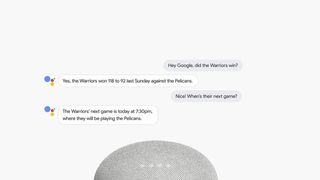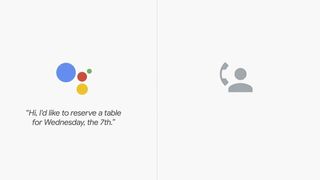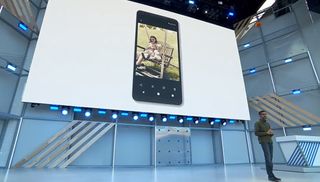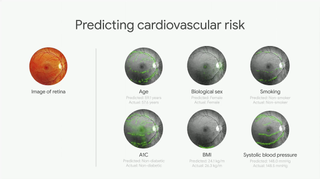Google I/O 2018: What's New with Google Assistant, Android P, Maps and More
At Google I/O 2018, Google Assistant stole the show with a scary-real demo of it carrying on conversations for users. And there's a whole new UI for Android P.
MOUNTAIN VIEW - Google CEO Sundar Pichai kicked off Google I/O 2018 with a nod to the Facebook controversy, but the event quickly segued to just how fricking smart its tools are becoming through AI machine learning.
The most amazing demo? Google Assistant carrying on a conversation on behalf of the user. But there's lots of compelling new features in Android P, as well, and it's available in beta today.
“There are very real and important being raised about the impact of the test advance and the role they’ll play in our lives,” said Pichai. “We feel a deep sense of responsibility to get this right.”

Google’s continued mission is to “solve problems for users around the world,” and there were many solutions on display, especially around Google Assistant.
Google Assistant: More Voices, Continued Conversations and More
Google Assistant is getting a more natural sounding voice, complete with pitch, pace and pauses. Actually, Assistant is getting six new voices (male and female). Even John Legend’s voice is coming to Google Assistant later this year.
Google can do all of this by extrapolating on a short recording session.

Google’s Scott Huffman talked about other advances in Google Assistant. One of the top new features is Continued Conversation, which will allow you to keep talking to the assistant without having to continually say “Hey, Google.”
You’ll also be able to perform Multiple Actions, which means you’ll be able to combine different requests into one. So, for example, you could turn on your popcorn maker and fire up the Warriors’ game on TV at the same time.
To help teach our children manners, Google is encouraging kids to say “Please,” and the Assistant is responding with positive reinforcement.
Sign up to get the BEST of Tom’s Guide direct to your inbox.
Upgrade your life with a daily dose of the biggest tech news, lifestyle hacks and our curated analysis. Be the first to know about cutting-edge gadgets and the hottest deals.
Google Smart Displays, which are similar to the Amazon Echo Show, will be on sale this July and will integrated with YouTube TV. You'll also be able to do video calls, preview your commute and more.

You won't have to purchase a Smart Display to get visual assistance, as Google Assistant on your phone will be able to do things like re-order your last order from Starbucks (you can confirm on the screen), as well as say "make it warmer" and then address the thermostat control right from the Google Assistant screen. In a way, Google Assistant is making standalone apps obsolete.
The most amazing demo was Google Duplex, which showed how Google Assistant could book a haircut for you by making the call and even answering the questions for you. The fact that Google Assistant could carry on a conversation for you is amazing.

Last but not least, Google Assistant is coming to Google Maps this summer.
Android P: Smarter AI, New Swipe UI

With Android P, the big focus (not surprisingly) is AI. Adaptive battery uses on-device machine learning, which tries to adapt to your usage patterns based on the apps you use and at what times of day.
Google is seeing a 30 percent reduction in CPU app wake-ups.
A new Adaptive Brightness setting adjusts the brightness based on your preferences. You’ll wind up making less manual adjustments.
The UI in Android P is getting more intelligent, too. Google is predicting actions, like calling a specific contact or starting a workout. And you’ll see these App Actions right on the home screen.
When you search for the new Avengers movie, you’ll see a suggestion action that will give you deep links to buy tickets in the Fandango app.
A new Android Slices feature brings bits of apps into your search results. So, for example, you’ll be able to order a ride from Lyft. An early access program is coming next month for developers.
Android P is getting an iPhone X-like interface, too. So, you can swipe up from the bottom of the display to see all of your open apps, and then you can swipe up again to see all of your apps. But it's not just a carbon copy of Apple. You'll see thumbnails of your favorite apps in the initial card view, as well as a Google search box.
With Android P, Google is also trying to save us from our phone addictions. Android P will show you how much time you’ve been spending on your device, as well was break down of how much you’re using each app.
The OS will also try to help you be more present with a new Do Not Disturb Mode. Just turn your phone over to engage it, so you won’t be pinged or vibrated. However, you’ll still be able to reached by Starred Contacts. Fade screen from grayscale at 10 pm, less engaging.
Android P Beta is available starting today on Google Pixel.
Google Maps
With the new Google Maps, Google is focusing on discovery. It will be recommending places to go like restaurants but in a way that leverages machine learning. You’ll see a Your Match score, which is based on places you’ve been to or others that you’ve rated. It’s like a more personalized Yelp.

If you long press on any place, you can add it to your short list and then share the list out with friends. Your friends an then vote in real-time, so there should be less copying and pasting.
These features are coming to Google Maps on Android and iOS later this summer.
Gmail and Google Photos: New Features on Way
Gmail is getting a new feature called Smart compose, which is rolling out to to all users this month. The idea is to auto-suggest phrases based on what you’re typing. So Gmail can automatically enter your address when you’re typing or other phrases based on context.

Google Photos is getting smarter as well. For example, the app can see when your friend Lisa is in a pic and suggest that you share it with her. And if you have a black and white photo, Google Photos can colorize it.
The coolest new feature coming to Google Maps appears when you’re navigating on foot. A new view shows your camera view so you’ll know whether you’re going in the right direction. You’ll even see ratings for businesses as you pan around in real time.
Google Lens: Copy and Paste Text From Real World?
In the next few weeks the Google Lens feature will get a lot brainier. For starters, it will be able to understand and recognize words.
You can copy and paste from then real world into your phone. Or you could see photos pop up of dishes and their ingredients that you’re looking at on a menu.
With Style Match, you can see a shirt or pants and Google will find something that looks the same or similar.
Google Lens is also getting more proactive, as it will just start looking for objects like books as you pan the camera around. If you point your phone at a poster of a music artist, you’ll see a YouTube video pop up.
Google News: Completely New Design
Google News is getting a major overhaul, and it will be available to everyone starting next week. The look and feel is more modern, and you can quickly catch up on headlines via a personalized feed of news. There's also bigger images and a better video experience.

Other features include Newscasts, which brings together everything from trailers to Tweets and quotes. You can also drill deeper on topics with Full coverage. The goal is to provide a real-time event understanding.
A new Newstand section will provide access to more than 1,000 titles. Subscribe with Google lets you use your Google account to access paid content across all of your devices. Google is working with 60 publishers and will be rolling out in the coming weeks.
Autos: Predicting Red Light Runners
Alphabet’s Waymo, which focuses on self-driving cars, showed off a new way to identify pedestrians through machine learning. More impressive, the company can predict when a car in front of you may run a red light and slow you down.
Waymo has driven more than 5 billion miles in simulation, so it’s getting better at helping navigate in all sorts of conditions, including snow storms.
Using AI for Good
Google has been opening AI centers around the world. Bringing expert diagnosis where doctors aren’t available. Eye scans, for example, can predict cardiovascular risk.

Google is also working to help doctors predict medical events. We can quantitative predict the chance of re-admission by looking at over 100,00 data points.
AI can also help with accessibility. Google showed a clip from ESPN’s First Take where it was able to separate speakers and silence the person talking over the other, so you’re better able to follow the conversation.

Google has also found a way for this who are disabled to communicate via Morse code, turning it into a digital voice. This is a bid upgrade for someone who used to have to use head gear.
Mark Spoonauer is the global editor in chief of Tom's Guide and has covered technology for over 20 years. In addition to overseeing the direction of Tom's Guide, Mark specializes in covering all things mobile, having reviewed dozens of smartphones and other gadgets. He has spoken at key industry events and appears regularly on TV to discuss the latest trends, including Cheddar, Fox Business and other outlets. Mark was previously editor in chief of Laptop Mag, and his work has appeared in Wired, Popular Science and Inc. Follow him on Twitter at @mspoonauer.

